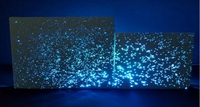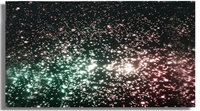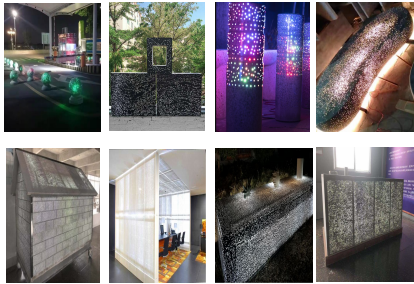Optical fiber used in concrete architectural lighting
1. What is translucent concrete?
PMMA new building materials light-emitting fiber optic cement concrete brick products
Translucent concrete (aka: light-transmitting concrete) is a concrete-based building material with light-transmitting properties due to embedded optical elements - usually optical fibers. Light travels through the stone from one end to the other.
Therefore, the fibers must pass through the entire object. This creates some kind of light pattern on the other surface, depending on the fiber structure. Shadows cast to one side appear as contours There are several methods of producing translucent concrete. All based on fine-grained concrete (about 95%) and only 5% light guide elements added during casting. After setting, the concrete is cut into slabs or stone, and the stone is cut with standard machinery. Translucent concrete is used in fine architecture as façade material and interior wall cladding. Translucent concrete is also used in various design products. Using natural light must ensure that enough light is available. Wall-mounted systems need to be equipped with some form of lighting aimed at uniform lighting across the plate surface. Usually the installation system is similar to using natural stone panels, for example, LUCEM uses perforated installation with visible screws.

2.Characteristics and principles of translucent concrete:
1. Soft glow, not dazzling
2. Simple installation and convenient construction.
3. Various sizes, patterns and patterns can be customized.
4. High light transmittance, strong compression resistance and good thermal insulation performance.
The light-emitting principle of light-transmitting concrete: in the daytime, when the sun shines, the light enters the interior through the building, and when the light is on at night, the exterior of the building can vaguely reveal the interior scene. The designer uses a special building material: light-transmitting concrete, this kind of material that makes the cold building dynamic, it is based on 3 main components: the interaction of concrete, fiber and light, its principle, The special glass fiber is processed into the concrete, and the surface is irradiated by artificial light or natural light, and is transmitted from one end to the other end, thereby making it light-transmitting

3. Types of translucent concrete:
At present, the brands of light-transmitting concrete at home and abroad have developed the types of light-transmitting concrete, which are roughly divided into three categories: point distribution, linear walk and customized walk. The colors are concrete, black, white and so on.
The effects presented by these three categories are different: point-like and linear are fixed styles, while custom categories can customize logo, slogan, etc., which are very stylized. Through the final generated light-transmitting panel, viewers can clearly see The silhouette of the object on the other side of the concrete, with this clarity, the translucent concrete still maintains its strong, crack-resistant, and load-bearing qualities.

4. Application of light-transmitting concrete:
Since its development, light-transmitting concrete has been widely used in:
1. Wall decoration, indoor and outdoor stair facade or step decoration, it can play the same role as decorative light strips, 2. It can be used for indoor and outdoor image decoration, and the color can be very changeable, whether it is inside the office, The hotel is also the entrance of the foyer opposite the residential building, indoor wall tiles, bars, KTV wall tiles, construction site buildings, park balls, indoor kitchens, park stools, wall displays, office buildings, facade decoration, large building exterior wall decoration, Offices, luminous displays at conferences, lounges, toilets, corridors, front desks, counters, stone benches, etc. are all very eye-catching. 3. It can be cut into bricks and stacked for decoration in the form of bricks.
4. It can be used for the ground. The BABOR headquarters in Aachen, Germany, makes good use of this on the ground of the office exterior. The Aachen headquarters in Sanya also uses light-transmitting concrete bricks to guide and decorate the ground. 5. Lamps can be customized, unique, 6. Even indoor and outdoor furniture, seating, tabletops, etc. can be customized. Located in Munich Airport in Germany, on the square outside the terminal building, scattered decorative cubes also use light-transmitting mixed Soil is the finishing touch.

4. Shenzhen Jinzhi Photoelectric Technology Co., Ltd. provides the following designs for light-transmitting concrete:












































